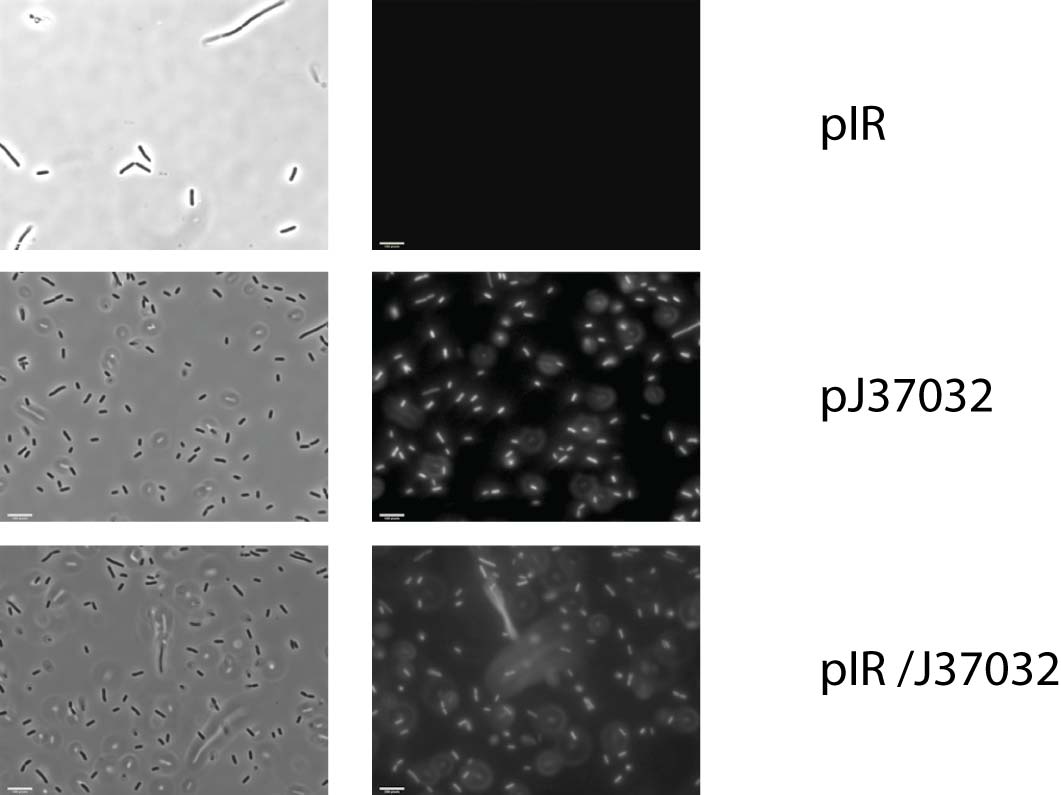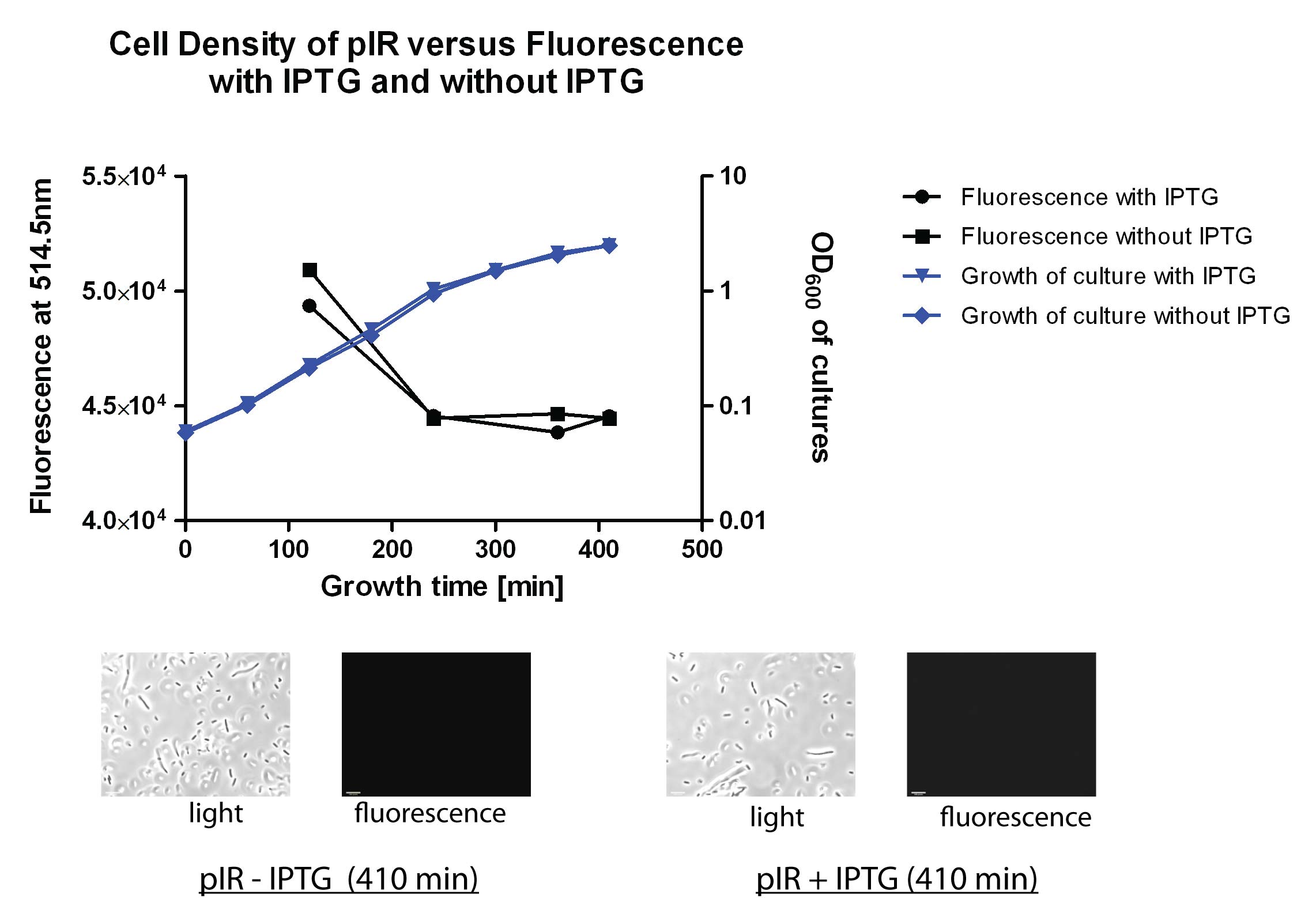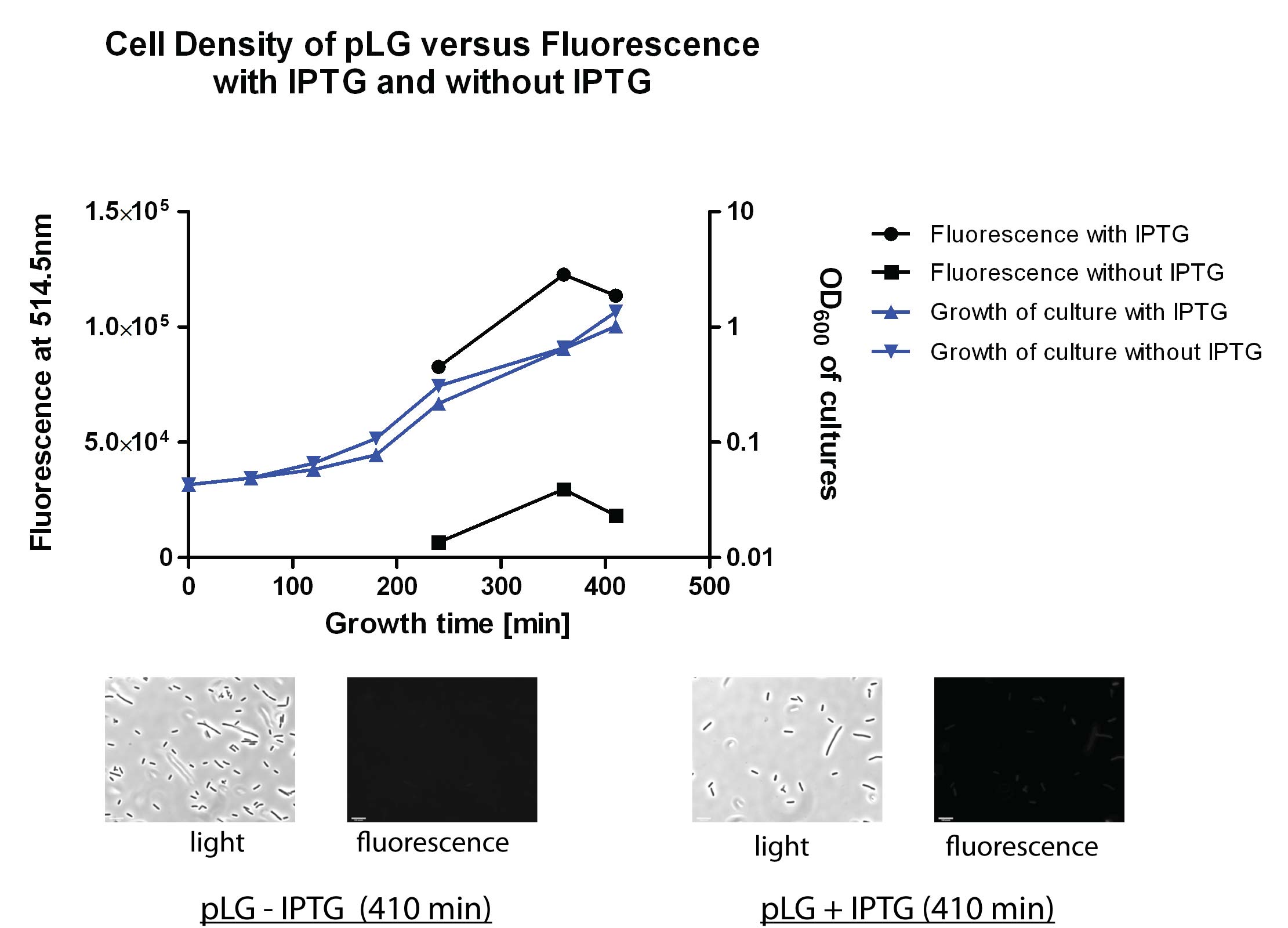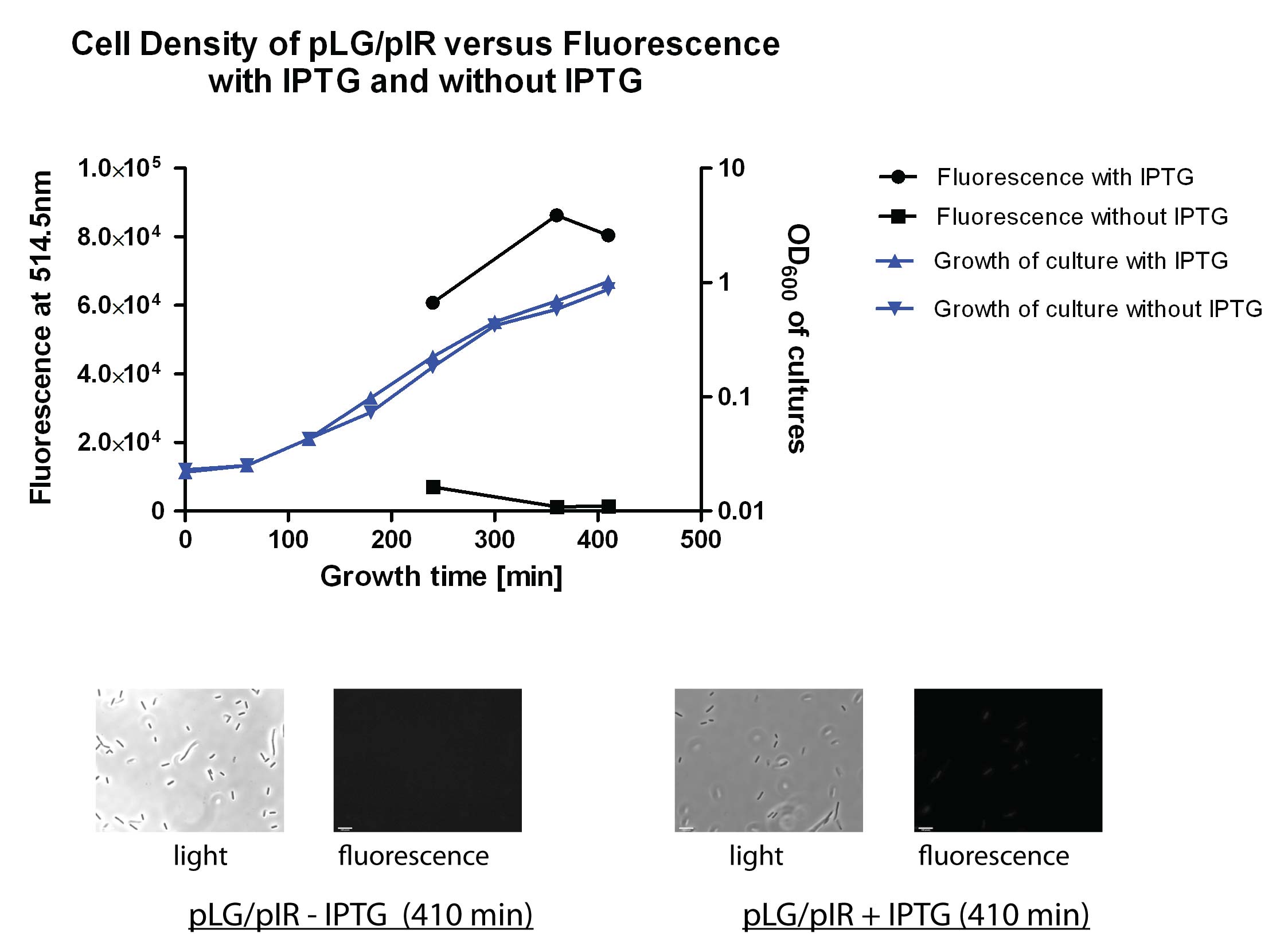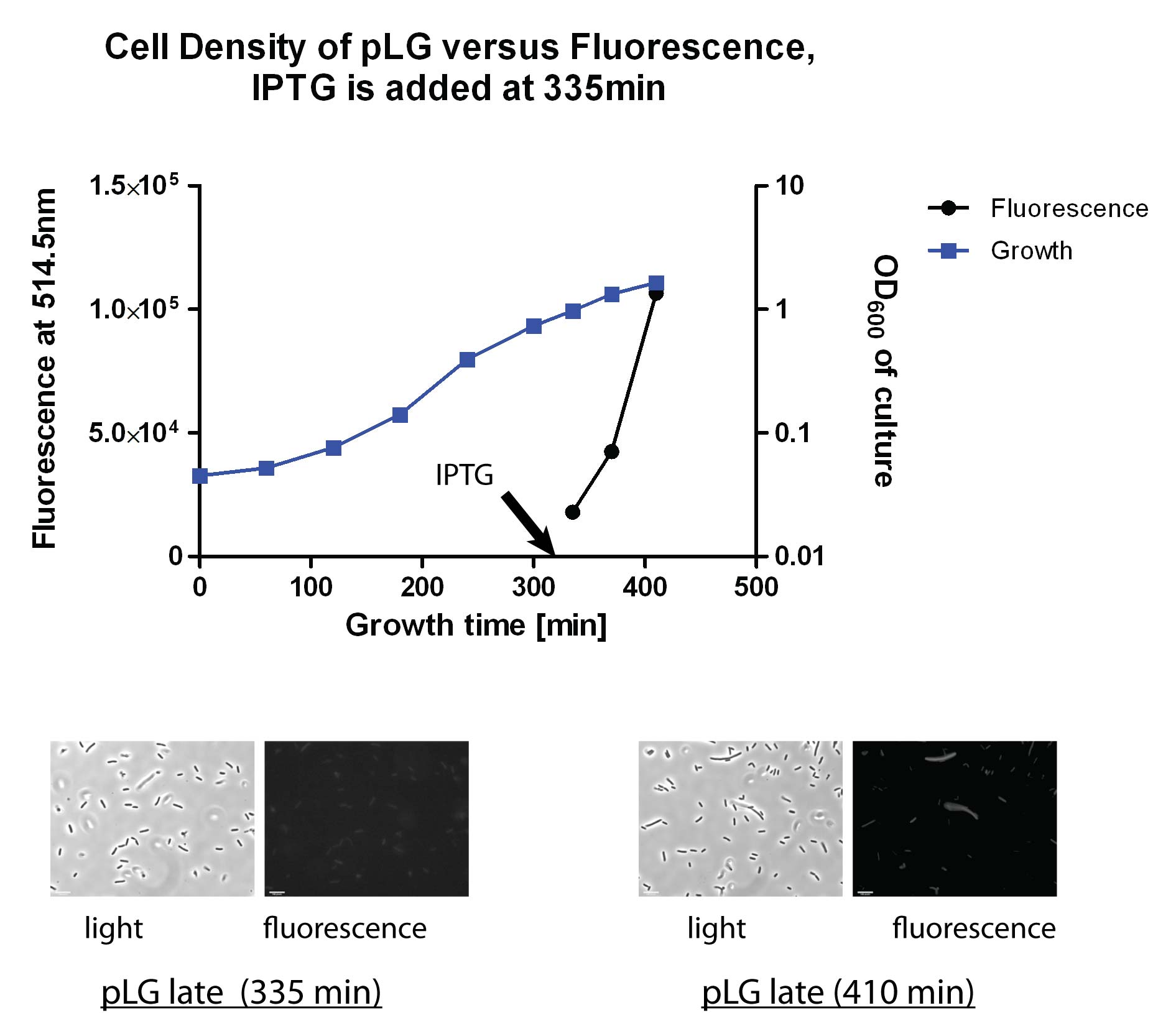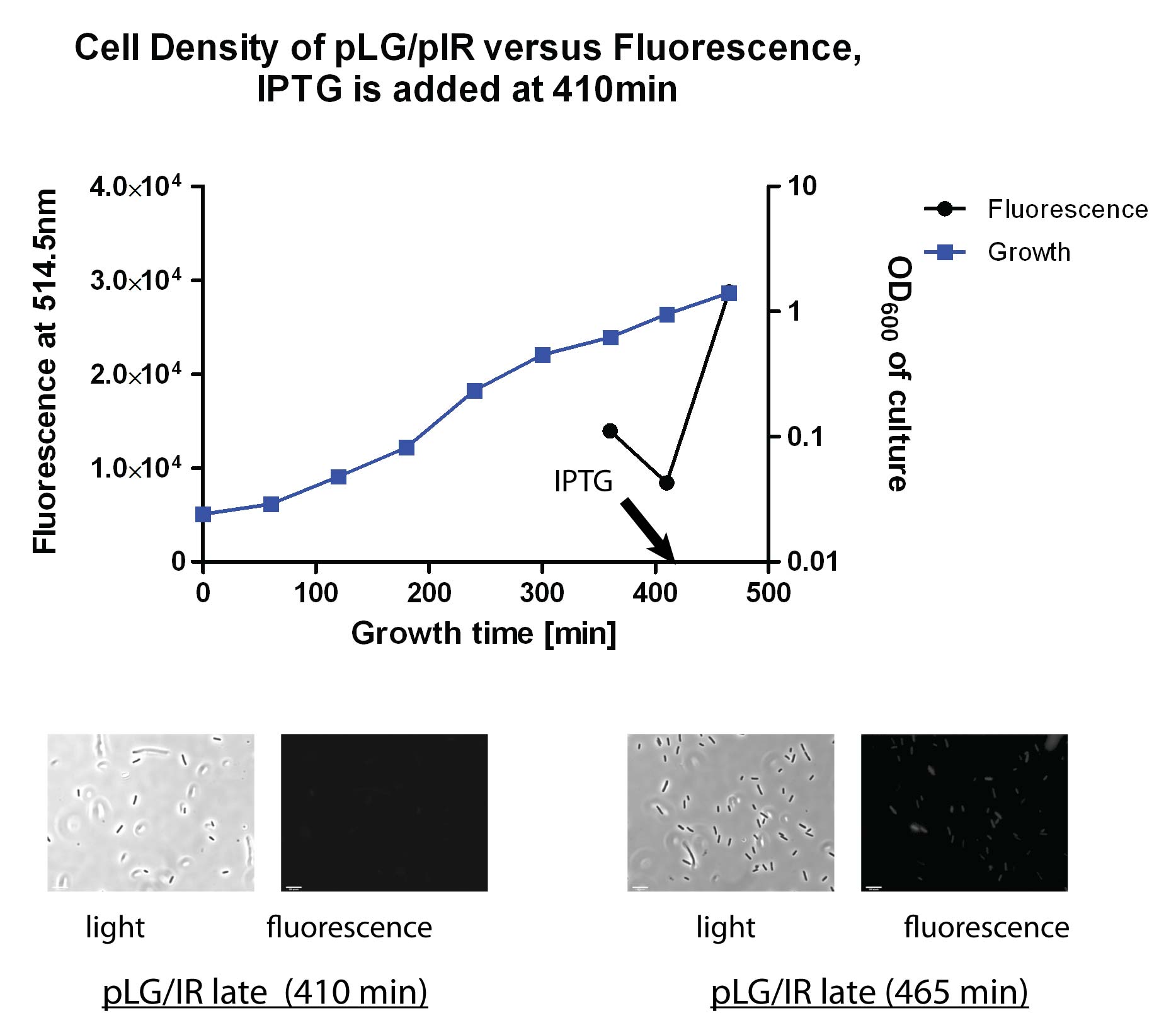Team:Aberdeen Scotland/WetLab/quorumsensing/results
From 2009.igem.org
(→Results and Discussion) |
(→Results and Discussion) |
||
| Line 8: | Line 8: | ||
<b>Aims and background for testing our Quorum Sensing construct <partinfo>BBa_K182200</partinfo></b><br><br> | <b>Aims and background for testing our Quorum Sensing construct <partinfo>BBa_K182200</partinfo></b><br><br> | ||
| - | In our first series of experiments, we wanted to test whether our quorum sensing construct <partinfo>BBa_K182200</partinfo> (expressing LuxI and LuxR and hereafter referred to as pIR) is functional, and is capable of inducing a pLux promoter. As a test of <partinfo>BBa_K182200</partinfo> (pIR)function the reporter construct <partinfo>BBa_J37032</partinfo> was used. <partinfo>BBa_J37032</partinfo> consists of a pLux promoter and the gene for the green fluorescent protein. | + | In our first series of experiments, we wanted to test whether our quorum sensing construct <partinfo>BBa_K182200</partinfo> (expressing LuxI and LuxR and hereafter referred to as pIR) is functional, and is capable of inducing a pLux promoter. As a test of <partinfo>BBa_K182200</partinfo> (pIR) function the reporter construct <partinfo>BBa_J37032</partinfo> was used. <partinfo>BBa_J37032</partinfo> consists of a pLux promoter and the gene for the green fluorescent protein. |
<br><br>For this purpose SCS1 <i> E.coli </i> cells were transformed with 1) pIR alone, 2) <partinfo>BBa_J37032</partinfo> alone, and 3) pIR and J37032 together. The pIR transformant represents the negative control. Without any GFP gene inside the cells they should not fluorescent. The <partinfo>BBa_J37032</partinfo> transformant should also not fluorescent as the promoter needs to be activated by quorum sensing and this single transformant is not expressing the required LuxI/LuxR combination. The double transformant should show low fluorescence at low cell density and high fluorescence at high cell density as quorum sensing is triggered.<br><br>Pictures were taken from over night cultures, i.e. at high cell density, under a light microscope (left hand-side) and a fluorescence microscope (right hand-side) from the 3 different SCS1 <i> E.coli </i> cell transformants. No fluorescence was exhibit by the pIR-only transformants. However, the single J37032 transformants shows as high a fluorescence as the double transformants. <br><br> | <br><br>For this purpose SCS1 <i> E.coli </i> cells were transformed with 1) pIR alone, 2) <partinfo>BBa_J37032</partinfo> alone, and 3) pIR and J37032 together. The pIR transformant represents the negative control. Without any GFP gene inside the cells they should not fluorescent. The <partinfo>BBa_J37032</partinfo> transformant should also not fluorescent as the promoter needs to be activated by quorum sensing and this single transformant is not expressing the required LuxI/LuxR combination. The double transformant should show low fluorescence at low cell density and high fluorescence at high cell density as quorum sensing is triggered.<br><br>Pictures were taken from over night cultures, i.e. at high cell density, under a light microscope (left hand-side) and a fluorescence microscope (right hand-side) from the 3 different SCS1 <i> E.coli </i> cell transformants. No fluorescence was exhibit by the pIR-only transformants. However, the single J37032 transformants shows as high a fluorescence as the double transformants. <br><br> | ||
[[Image:J37TEST_figure.jpg|center|600 px]] | [[Image:J37TEST_figure.jpg|center|600 px]] | ||
| - | <br><br>Those results suggest that <partinfo>BBa_J37032</partinfo> is not responsive to | + | <br><br>Those results suggest that reporter construct<partinfo>BBa_J37032</partinfo> is not responsive to quorum sensing as it does not need LuxI/LuxR to produce GFP. In other words, the pLux promoter in J37032 seem to be extremely leaky. This <partinfo>BBa_J37032</partinfo> construct was therefore revealed by these experiments as an unsuitable reporter of LuxI/LuxR quorum sensing. <br><br> |
| - | + | In a further series of experiments, the pIR construct <partinfo>BBa_K182200</partinfo> was re-tested with the pLux responsive promoter construct <partinfo>BBa_K182101</partinfo> created by the Aberdeen Team. <partinfo>BBa_K182101</partinfo> (further referred to as pLG represents and AND-Gate promoter controlling the expression of GFP; it requires two inputs to initiate the transcription of GFP, firstly IPTG to release LacO repression and secondly quorum sensing, in the form of LuxR-homoserine-lactone for triggering the pLux promoter. <br><br> SCS1 cells were transformed with either 1) pTrc99A and pIR, 2) pTrc99A and pLG or 3) pTrc99A, pIR and pLG. The plasmid pTrc99A contains the gene lacI<sup>q</sup> which over-produces LacI. This is needed to sufficiently suppress the Lac operator in the hybrid pLux-LacO promoter in the pLG construct in the starting cultures. It is expected that a high fluorescence occurs only in the pTrc99A, pIR and pLG triple transformed cells and only when IPTG is added and the cells are at a high density to trigger quorum sensing. The pTrc99A and pIR transformant lacks the gene for GFP and hence should show no fluorescence at all; this acts as a negative control. The pTrc99A and pLG double transformant one lacks qourum sensing ability, since it expresses neither LuxI or LuxR. It thereby should not show fluorescence at any cell density, whether ITPG is added or not.<br><br>GFP fluorescence was then assessed in the three tranformant types.<br><br>The graph below show the negative control (pTrc99A and pIR double transformant). All quantitative fluorescence measurements in these experiments were taken with the help of a fluorimeter at an emmision wavelength of 514.5nm, and an excitation wavelength of 490nm. As this negative control expresses no GFP these fluorescence values were said to be the background reading of the cells and the mean of those values were subtracted from all of the subsequent measurements before the graphs were plotted. Also, under the fluorescence microscope no fluorescence were observed as expected for the pTrc99A and pIR double transformant.<br><br> | |
[[Image:PIR_figure.jpg|center|600 px]] | [[Image:PIR_figure.jpg|center|600 px]] | ||
Revision as of 09:01, 14 October 2009
University of Aberdeen - Pico Plumber
Results and Discussion
Aims and background for testing our Quorum Sensing construct
In our first series of experiments, we wanted to test whether our quorum sensing construct (expressing LuxI and LuxR and hereafter referred to as pIR) is functional, and is capable of inducing a pLux promoter. As a test of (pIR) function the reporter construct was used. consists of a pLux promoter and the gene for the green fluorescent protein.
For this purpose SCS1 E.coli cells were transformed with 1) pIR alone, 2) alone, and 3) pIR and J37032 together. The pIR transformant represents the negative control. Without any GFP gene inside the cells they should not fluorescent. The transformant should also not fluorescent as the promoter needs to be activated by quorum sensing and this single transformant is not expressing the required LuxI/LuxR combination. The double transformant should show low fluorescence at low cell density and high fluorescence at high cell density as quorum sensing is triggered.
Pictures were taken from over night cultures, i.e. at high cell density, under a light microscope (left hand-side) and a fluorescence microscope (right hand-side) from the 3 different SCS1 E.coli cell transformants. No fluorescence was exhibit by the pIR-only transformants. However, the single J37032 transformants shows as high a fluorescence as the double transformants.
Those results suggest that reporter construct is not responsive to quorum sensing as it does not need LuxI/LuxR to produce GFP. In other words, the pLux promoter in J37032 seem to be extremely leaky. This construct was therefore revealed by these experiments as an unsuitable reporter of LuxI/LuxR quorum sensing.
In a further series of experiments, the pIR construct was re-tested with the pLux responsive promoter construct created by the Aberdeen Team. (further referred to as pLG represents and AND-Gate promoter controlling the expression of GFP; it requires two inputs to initiate the transcription of GFP, firstly IPTG to release LacO repression and secondly quorum sensing, in the form of LuxR-homoserine-lactone for triggering the pLux promoter.
SCS1 cells were transformed with either 1) pTrc99A and pIR, 2) pTrc99A and pLG or 3) pTrc99A, pIR and pLG. The plasmid pTrc99A contains the gene lacIq which over-produces LacI. This is needed to sufficiently suppress the Lac operator in the hybrid pLux-LacO promoter in the pLG construct in the starting cultures. It is expected that a high fluorescence occurs only in the pTrc99A, pIR and pLG triple transformed cells and only when IPTG is added and the cells are at a high density to trigger quorum sensing. The pTrc99A and pIR transformant lacks the gene for GFP and hence should show no fluorescence at all; this acts as a negative control. The pTrc99A and pLG double transformant one lacks qourum sensing ability, since it expresses neither LuxI or LuxR. It thereby should not show fluorescence at any cell density, whether ITPG is added or not.
GFP fluorescence was then assessed in the three tranformant types.
The graph below show the negative control (pTrc99A and pIR double transformant). All quantitative fluorescence measurements in these experiments were taken with the help of a fluorimeter at an emmision wavelength of 514.5nm, and an excitation wavelength of 490nm. As this negative control expresses no GFP these fluorescence values were said to be the background reading of the cells and the mean of those values were subtracted from all of the subsequent measurements before the graphs were plotted. Also, under the fluorescence microscope no fluorescence were observed as expected for the pTrc99A and pIR double transformant.
The second control was the SCS1 strain transformed with pTrc99A and pLG. It is expected that when grown with or without IPTG no fluorescence occurs. When grown with IPTG there might occur some fluorescence due to leakiness of the pLux promoter. The results below show hardly any fluorescence for the culture grown without IPTG, but a high fluorescence when grown with IPTG. Measurements of fluorescence were taken after the cells reached an optical density of 0.200 at 600nm. This was chosen because it is suggested that Quorum Sensing only switches on at a much higher density than this.
Those results indicate that the Lac operator works as expected and is sufficiently repressed by LacI as no fluorescence occurs without IPTG. However, as no Quorum Sensing construct is transformed into this cell strain, the occuring fluorescence when adding IPTG cannot be due to Quorum Sensing and therefore leads to the belief that the pLux promoter is either extremely leaky or not responsive to LuxR/LuxI and does not function as predicted.
The next diagram shows the fluorescence of the triple transformed cells over cell density, grown with and without IPTG. Similar results than the pLG/pTrc99A transformance are observed. There is hardly any fluorescence present when no IPTG is present in the cell culture, however, a lot of fluorescence when IPTG is added. In this case this is actually expected at high cell density, as both inputs of the AND-gate - IPTG and Quorum Sensing - are provided. Never the less, Quorum Sensing appears to be switched on at low cell density as at the first measuring time of 240 minutes the optical density of the cultures were only 0.2 at a wavelength of 600nm. However, when the results from the double transformance pLG/pTrc99A are taken into account than this fluorescence might be the outcome of a malfunctioning pLux promoter.
Furthermore, two cultures were grown without IPTG up to an optical denisty of 1.0 at 600nm wavelength. This was done for the transformances with 1) pLG and pTrc99A and 2) pIR, pLG and pTrc99A. At this cell density it is presumed that some Quorum Sensing occurs in the second culture, but not in the first culture as no pIR construct is present. The picture below shows the first culture. It suggest that a high fluorescence occurs in a relative short time, i.e. 30 minutes. This leads to the believe that as in above experiments the AND-gate can be triggered by one input (the IPTG adding) alone and does not need Quorum Sensing.
The second culture contains the Quorum Sensing construct and it is therefore expected that as soon as IPTG is added the AND-gate is switched on and GFP production is triggered. The time delay until the fluorescence is developing represents the time needed to release the repression from the Lac operator. This was shown (see graph below). However, if compared with the control, i.e. the first culture, than no significant difference occurs.
In conculsion, it can be summarised that the Quorum Sensing construct could not be tested properly as both constructed which it was tested with do not work as expected and show no responsiveness to LuxR/LuxI. Additional, it can be said that the Lac operator in the AND-gate construct works very well and tightly respresses the transcription. However, the second input of the AND-gate construct is malfunction. Thereby the AND-gate does not work as expected and hoped for.
 Back to Cloning Strategy Back to Cloning Strategy
|
Continue to Beta Galactosidase Assay 
|
 "
"
